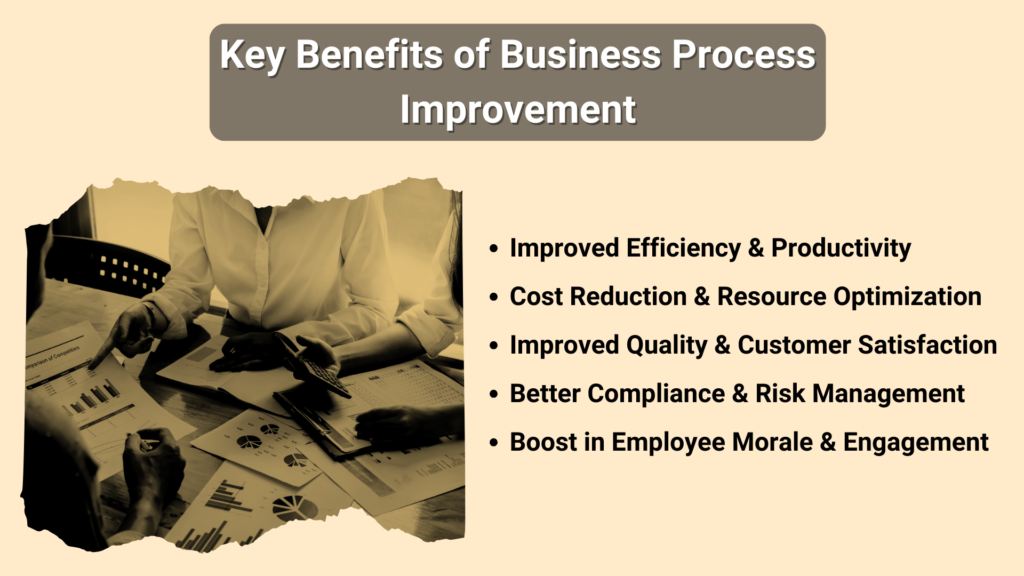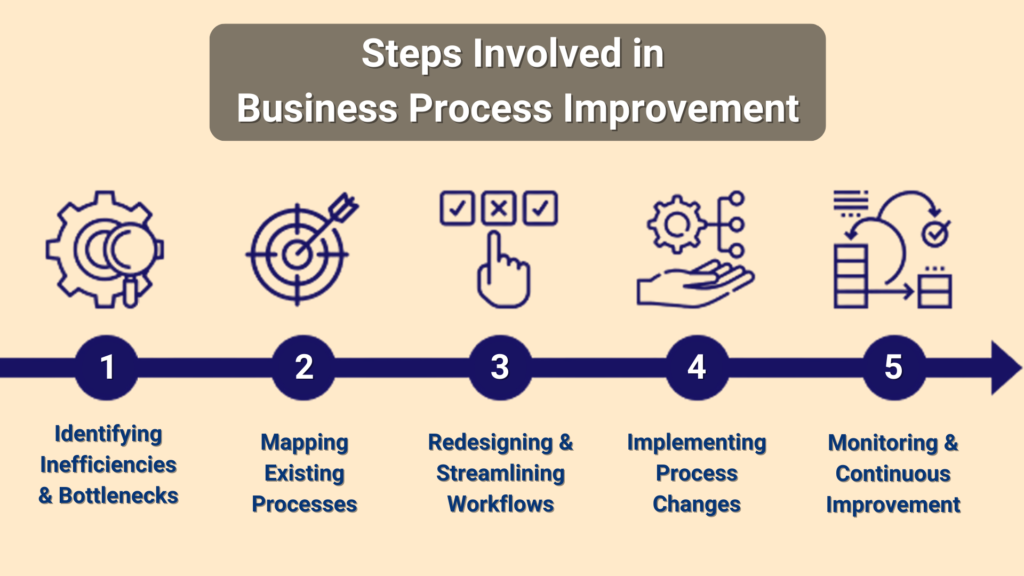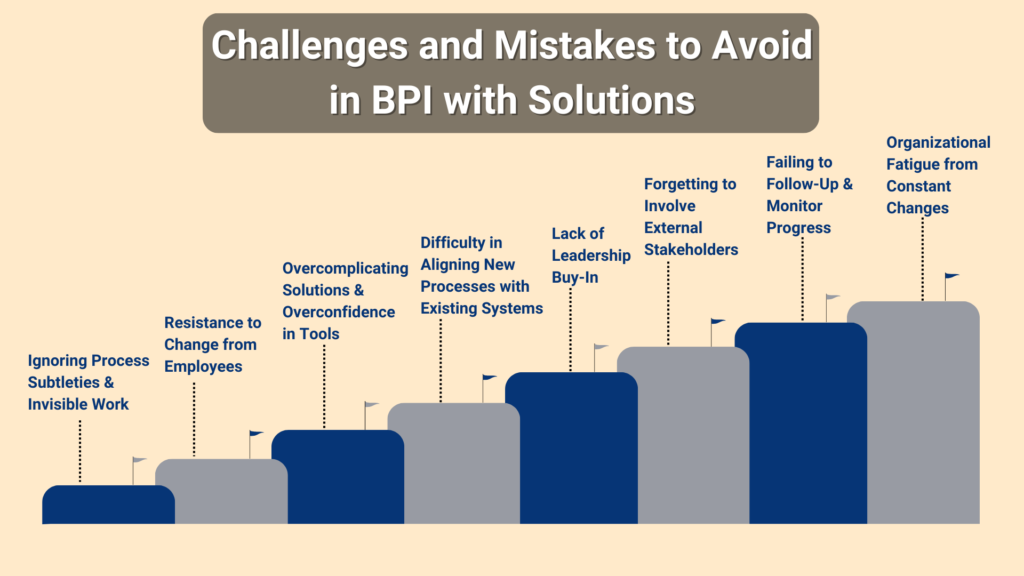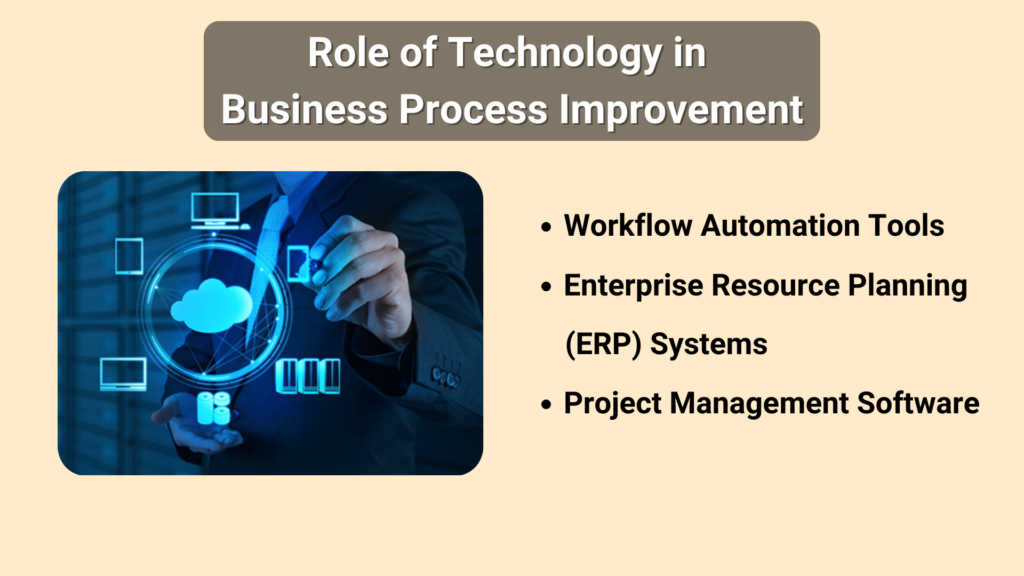Business Process Improvement (BPI) is essential for organizations seeking to remain competitive and achieve sustainable growth. By streamlining workflows and adopting modern technologies, companies can reduce costs, boost productivity, and maintain agility in today’s fast-paced market. BPI allows businesses to continuously adapt and refine their processes, ensuring long-term operational success.
What is Business Process Improvement (BPI)?
Business process improvement (BPI) is the practice of analyzing, redesigning, and optimizing business workflows to improve overall performance. It involves examining existing processes, identifying inefficiencies, and implementing changes that result in improved business processes, increased productivity, cost savings, and higher-quality outcomes. The ultimate goal of BPI is to ensure that every step in a process adds value and aligns with the organization’s objectives.
Continuous process improvement is a key aspect of BPI, where businesses consistently evaluate and refine processes to achieve better results. Areas that often benefit from BPI include customer service workflows, inventory management, project management, and financial reporting. If your business experiences bottlenecks, delays, or frequent quality issues, these are clear indicators that business process improvement is necessary.
Key Benefits of Business Process Improvement
Implementing Business Process Improvement (BPI) offers a wide range of benefits that can significantly enhance a company’s performance. By optimizing workflows and eliminating inefficiencies, businesses can experience:

- Improved Efficiency and Productivity: Streamlined processes reduce time spent on redundant tasks, allowing teams to focus on value-added activities. This leads to faster delivery times and higher productivity levels across the board.
- Cost Reduction and Resource Optimization: BPI helps identify wasteful activities and unnecessary steps in a process. By cutting out these inefficiencies, businesses can significantly lower operational costs while making better use of their existing resources.
- Improved Quality and Customer Satisfaction: Improved processes lead to fewer errors and higher-quality outputs, which translates to better customer satisfaction. A well-optimized workflow also ensures that businesses can meet customer demands promptly.
- Better Compliance and Risk Management: Streamlined processes help organizations maintain compliance with industry regulations and reduce the risk of errors or non-compliance. This is especially important for professional service businesses that need to meet strict regulatory standards.
- Boost in Employee Morale and Engagement: By eliminating frustrating bottlenecks and inefficiencies, employees are empowered to work more effectively. This leads to higher job satisfaction and morale, which in turn improves overall productivity.
Steps Involved in Business Process Improvement
Implementing business process improvement is a structured approach that involves several key steps. Each step plays a significant role in identifying inefficiencies and optimizing workflows for maximum impact.

Step 1: Identifying Inefficiencies and Bottlenecks
The first step in business process improvement is to thoroughly assess existing processes to identify areas of inefficiency. This includes pinpointing bottlenecks, redundant tasks, and any activities that do not contribute to the desired outcomes. For example, delays in approval processes or miscommunication between departments can significantly impact overall productivity.
Step 2: Mapping Existing Processes
Once inefficiencies are identified, the next step is to map out the current processes. Creating a clear, visual representation of workflows allows businesses to better understand how each step interacts and where improvements can be made. Process mapping also helps highlight any unnecessary steps that can be eliminated.
Step 3: Redesigning and Streamlining Workflows
With a detailed understanding of existing processes, the business can now focus on redesigning and streamlining workflows. This may involve simplifying complex steps, removing barriers, and integrating new tools or automation to improve efficiency. At this stage, it’s essential to ensure that any changes align with the business’s overall goals and meet customer expectations.
Step 4: Implementing Process Changes
After redesigning the processes, the next step is to implement the changes. This phase requires careful planning and communication with all stakeholders to ensure smooth execution. It’s important to train employees on the new workflows and provide support during the transition to avoid disruptions.
Step 5: Monitoring and Continuous Improvement
Business process improvement is an ongoing journey. Once the new processes are in place, continuous monitoring is essential to measure their effectiveness. KPIs and metrics should be tracked to ensure the changes are delivering the desired results. Regular feedback from employees and stakeholders is also critical for identifying additional areas for improvement.
Business Process Improvement Methodologies
To implement business process improvement effectively, companies often rely on proven methodologies that provide structure and guidance throughout the process. Each methodology has its strengths, and choosing the right one depends on your business’s needs and goals.
| Methodology | Key Focus | Strengths | When to Use | Industries/Environments |
| Lean Methodology | Maximizing value while minimizing waste | – Reduces waste – Lowers costs – Increases speed | Best for improving efficiency and cutting non-value-adding steps | Professional services, manufacturing, and operations |
| Six Sigma | Improving process quality through data | – Reduces defects – Minimizes variability – Uses DMAIC for process control | Ideal for businesses needing consistency and quality control | Manufacturing, service industries, and large corporations |
| Agile Business Process Management | Flexible, iterative process improvement | – Allows for quick, incremental changes – Highly adaptable | Effective in dynamic industries or when flexibility is required | Tech companies, project-based work, creative industries |
Choosing the right business process improvement methodology depends on your goals. Lean boosts efficiency by cutting waste, Six Sigma improves quality by reducing defects, and Agile allows flexible, incremental changes. Often, businesses combine these methods for customized results that fit their specific needs and industry demands.
Challenges and Mistakes to Avoid in BPI with Solutions

When implementing Business Process Improvement (BPI), businesses often face both internal and external challenges that can undermine success. Avoiding common mistakes and addressing challenges proactively ensures a smoother and more effective BPI process.
1. Ignoring Process Subtleties and Invisible Work
Many organizations overlook the subtle variations and invisible work within their workflows, assuming that documented processes are followed consistently across teams. Ignoring these nuances can lead to disruptions when changes are imposed.
- Why It Happens: Leadership may assume that all processes are standardized, but informal adjustments employees make are missing.
- Solution: Involve employees early and review both formal and informal practices to ensure all aspects are considered during the redesign.
2. Resistance to Change from Employees
Resistance to change is a common challenge when introducing new processes, especially if employees aren’t involved from the beginning.
- Why It Happens: Employees fear disruption and may be uncomfortable adapting to new workflows.
- Solution: Involve employees early, communicate the benefits clearly, and offer adequate training and support to ease the transition.
3. Overcomplicating Solutions and Overconfidence in Tools
A common mistake is over-relying on tools or technology to fix underlying inefficiencies without addressing core issues. While automation tools can improve processes, if the fundamental problems aren’t resolved, they can only expedite broken systems.
- Why It Happens: Teams may focus too much on technology, believing it will fix all problems.
- Solution: Prioritize understanding the root causes of inefficiencies before automating and implementing simple, effective solutions that address the core issues.
4. Difficulty in Aligning New Processes with Existing Systems
Integrating new processes with outdated or incompatible systems can be a major obstacle in implementing BPI successfully.
- Why It Happens: Businesses may not fully analyze existing infrastructure before introducing changes.
- Solution: Conduct a thorough review of existing systems and engage IT teams early to ensure new processes align with current technologies.
5. Lack of Leadership Buy-In
Without active support from senior management, BPI efforts can lose momentum and fail to achieve lasting success.
- Why It Happens: Leadership may not fully understand the strategic value of BPI.
- Solution: Present data-driven insights on ROI and efficiency gains to inspire leadership and keep them involved throughout the process.
6. Forgetting to Involve External Stakeholders
External stakeholders such as suppliers or customers may be affected by internal process changes, but they are often overlooked during the BPI process.
- Why It Happens: The focus tends to be on internal improvements, assuming external adjustments will follow naturally.
- Solution: Involve key external stakeholders early in the planning process to anticipate potential disruptions and ensure smooth transitions.
7. Failing to Follow-Up and Monitor Progress
Some businesses fail to monitor the impact of BPI after initial implementation, missing opportunities for further optimization.
- Why It Happens: BPI is often treated as a one-time event rather than a continuous improvement cycle.
- Solution: Establish KPIs and use feedback loops to ensure processes are regularly evaluated and improvements are ongoing.
8. Organizational Fatigue from Constant Changes
Employees may experience fatigue from too many process changes in a short period, leading to resistance or lower morale.
- Why It Happens: Teams may assume that since past changes were successful, employees are ready for more.
- Solution: Stagger process improvements over time, clearly communicating the need and impact of each change to maintain commitment and prevent burnout.
Role of Technology in Business Process Improvement
In today’s ever-evolving business environment, technology plays a significant role in driving successful business process improvement (BPI) initiatives. By leveraging the right tools and systems, businesses can streamline workflows, automate repetitive tasks and gain valuable insights that lead to more efficient operations.

Workflow Automation Tools
One of the most significant ways technologies optimize BPI is through automation. Workflow automation tools help businesses eliminate manual, time-consuming tasks by automating repetitive processes. For instance, businesses can use software to automate approvals, track project timelines, and generate reports automatically. This not only increases speed and accuracy but also frees up employees to focus on more strategic tasks.
Enterprise Resource Planning (ERP) Systems
Enterprise Resource Planning (ERP) systems integrate multiple business functions—such as finance, supply chain, and customer relationship management—into one unified platform. This integration eliminates redundancy, centralizes data, and aligns processes with organizational goals. ERP systems, especially those designed for professional services businesses, often incorporate workflow automation and project management tools within a single platform. By doing so, these systems streamline operations, reduce the need for multiple software solutions and enhance overall process efficiency.
Project Management Software
Effective project management is essential for BPI, especially for businesses handling large-scale or complex projects. Tools like Asana, Trello, and Microsoft Project offer a centralized platform for tracking tasks, collaborating across departments, and managing timelines. These platforms ensure that process improvements are implemented efficiently and on schedule.
Examples/Case Studies of Business Process Improvement Success
To better understand the impact of business process improvement (BPI), let’s explore three public examples where companies successfully implemented BPI strategies and saw significant operational improvements. We also have an example for one of our clients.
Example 1: IBM's Business Process Improvement Initiative
IBM, a global leader in technology and consulting, launched a comprehensive business process improvement initiative to address inefficiencies across its operations. With multiple divisions and services, IBM faced challenges in efficiently managing workflows, particularly in project management and client billing.
To address these issues, IBM implemented automated solutions throughout various departments, including advanced project management systems and financial tracking tools. By leveraging analytics and automation, IBM eliminated constraints and reduced reliance on manual entry. The company also applied modern process improvement methodologies to ensure that these changes were sustainable and scalable.
Result: IBM saw faster project turnaround times, improved billing accuracy, and a significant reduction in operational costs. These improvements helped IBM become more agile, boosting its profitability and enhancing service delivery efficiency.
Example 2: Clifford Chance Reduces Operational Bottlenecks with Cloud-Based Solutions
Clifford Chance, one of the world’s largest legal firms, struggled with delays in managing client documentation, leading to inefficiencies in case handling and billing. These bottlenecks, largely due to manual document tracking, slowed the firm’s ability to deliver services promptly. The firm needed help improving business processes to streamline operations.
To improve, Clifford Chance adopted a cloud-based document management system (iManage), streamlining internal processes for better document access and organization. This BPI initiative helped the firm implement effective process improvement methodologies across departments, significantly reducing workflow inefficiencies.
Result: The firm reduced document handling times by 25% and saw a 30% improvement in case resolution efficiency. This transformation also improved client communication and responsiveness, resulting in higher productivity and customer satisfaction.
Example 3: Deloitte's Business Process Improvement in Professional Services
Deloitte, a renowned consulting firm, encountered operational inefficiencies when managing large-scale client projects across multiple regions. To address project tracking, resource management, and billing challenges, Deloitte implemented a business process improvement initiative.
The company introduced advanced project management tools and automated financial tracking systems, utilizing cloud-based platforms and data analytics to streamline workflows. These efforts, supported by Deloitte’s consulting expertise, helped the firm apply cutting-edge process improvement methodologies. This allowed Deloitte to track billable hours more effectively and allocate resources across teams efficiently.
Result: Deloitte saw significant improvements in project delivery times and billing accuracy. The changes led to more efficient resource allocation, better client communication, and increased client satisfaction, ultimately boosting profitability.
Example 4: Office of a large Market Research Group
At Haile Solutions, we were contacted by a market research group because it was suffering from operational inefficiencies with its operations and general project management. This created knock-on staff morale issues.
We did a thorough business process review and identified the bottlenecks, issues with working in silos, and noncompliance to the processes. We advised and assisted the business to implement the changes.
Result: Was more streamlined processes, better communication, and (most importantly for this particular client) improved staff morale.
These business process improvement examples show how customized strategies can significantly boost efficiency, productivity, and profitability. By streamlining workflows and leveraging automation, businesses not only solve current challenges but also lay the groundwork for future growth. For industries like professional services, collaborating with a business process improvement specialist can lead to long-term success.
Why Partner with Experts for Business Process Improvement?
While many businesses understand the value of business process improvement (BPI), the complexity of implementation often makes it beneficial to partner with experienced professionals. Consulting firms with expertise in BPI can help businesses not only streamline operations but also achieve long-term, sustainable success.
Benefits of Working with a Consulting Firm for BPI
- Expertise and Specialized Knowledge: Consulting firms bring years of experience and a deep understanding of various industries. They can identify inefficiencies and recommend targeted solutions that may not be apparent to internal teams.
- Objective Perspective: An external business process improvement consultant provides an unbiased view of the organization’s processes. This helps in identifying obstacles, redundancies and inefficiencies without the influence of internal politics or preconceived notions.
- Accelerated Results: With a well-structured plan and proven process improvement methodologies, expert consultants can expedite the BPI process. Their insights and hands-on approach ensure that improvements are implemented efficiently and without unnecessary delays.
- Sustainable Change Management: Consultants not only focus on immediate process improvements but also on ensuring that changes are sustainable in the long run. By developing clear strategies for managing change, business process improvement consulting services can help businesses avoid common pitfalls such as employee resistance or poor follow-up.
Why Haile Solutions?
At Haile Solutions, we specialize in helping professional service businesses streamline their processes, eliminate inefficiencies and enhance chargeability and billability. Our experienced consultants provide targeted business process improvement services that deliver lasting, impactful results. Whether it’s optimizing workflows, implementing new software, or guiding organizational change, our goal is to help businesses unlock their full potential through strategic consulting.
By partnering with Haile Solutions, businesses can focus on their core operations while we manage the complexities of process improvement. Our expertise in improving operational efficiency, reducing costs and managing change ensures measurable improvements and long-term success for your organization.
Frequently Asked Quetions
1. What are the most common signs that my business needs process improvement?
Common signs that your business may need process improvement include frequent bottlenecks, delays in delivering products or services, repetitive tasks, high operational costs, and inconsistent quality. If your business is struggling to keep up with client demands or experiencing inefficiencies, it might be time to consider a business process improvement initiative.
2. How long does it take to see results from business process improvement?
The timeline for seeing results from business process improvement varies depending on the complexity of the processes being addressed and the scope of the initiative. For smaller process changes, businesses may see improvements in weeks while larger projects involving multiple departments or systems could take several months. The key is continuous monitoring to ensure long-term success.
3. What tools are commonly used in business process improvement?
Common tools for BPI include workflow automation software, project management platforms (such as Asana, Trello, or Monday), and Enterprise Resource Planning (ERP) systems. These tools help businesses streamline processes, track tasks, and ensure that teams work more efficiently and effectively.
4. Can small businesses benefit from business process improvement?
Small businesses can benefit from business process improvement just as much as large enterprises. By streamlining operations and eliminating inefficiencies, small businesses can improve productivity, reduce costs, and improve customer satisfaction. Process improvement can provide small businesses with a competitive edge by allowing them to operate more efficiently with fewer resources.
5. How can I ensure that process improvements are sustainable?
To ensure sustainability, businesses should encourage employees in the process improvement journey and provide the necessary training. Additionally, regular audits, KPIs to track performance, and a commitment to continuous improvement will help maintain the benefits of BPI in the long run. Partnering with an expert consulting firm can also help ensure that improvements are implemented effectively and are built to last.






